Baritone guitars are characterized by a longer scale length than other standard guitar models. The scale length, or the distance between the nut and the saddle, varies depending on the type or model of guitar.
Models with a shorter scale include Mustang and Jaguar-style guitars, with a 24-inch scale (approximately 61 cm).
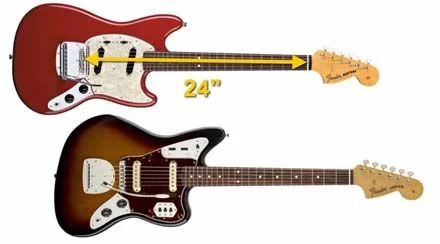
Next we have the models developed by Gibson such as the Les Paul and SG, with 24.75 inche scale (a little less than 63 cm).
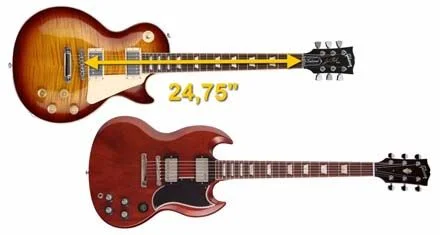
At 25.5 inches, we have the Telecaster, Stratocaster, and Superstratocaster models, with a scale length of nearly 65 cm.
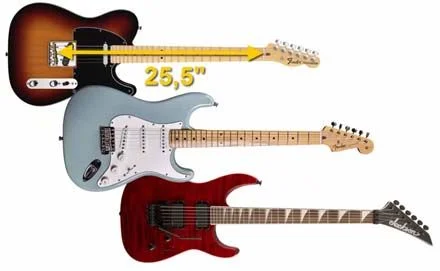
Scales and Tunings of Baritone Guitars
Above the 25.5-inch scale, we have baritone guitars. These models have been used by numerous guitarists, including James Hetfield of Metallica, John Petrucci, John Lennon, Glen Campbell, and Robert Smith of The Cure, among others.
Baritone guitars can be categorized into two groups: models with a scale length of around 27 inches, and those with a scale length of up to 30 inches.
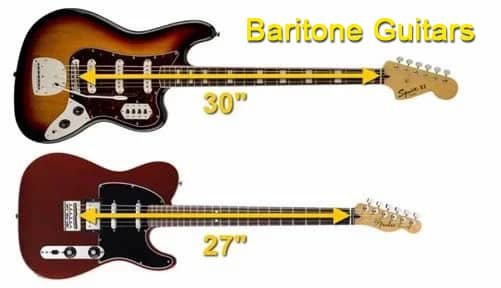
The 27″ models would sound closer to a standard guitar, while the 30″ models would be more like a bass guitar. This can be adjusted or modified depending on the guitar string gauge.
Danelectro Bass VI: The First Baritone Electric Guitar
The baritone guitar originated in classical music, but it was Danelectro that developed the first baritone electric guitar with a scale length of about 30 inches in the late 1950s. This gave rise to a hybrid model between a bass and a guitar, called the Danelectro Bass VI.
This instrument would begin to appear in Country and Surf music, and in the soundtracks of Western films.
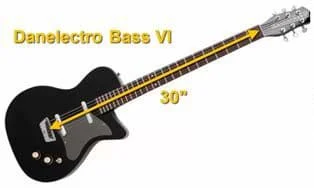
Fender Bass VI: A Reference in Baritone Guitars
To compete with Danelectro, Fender would later develop the Fender Bass VI. There is some confusion about this instrument, as some think the Fender Bass VI is a bass guitar. However, it is a baritone guitar, and I’ll explain this in detail below.
Initially, this instrument was designed as a kind of six-string bass, but clearly different from a standard six-string bass.
The six-string bass has a standard 34″ scale, and compared to a four-string bass, one more string is added toward the bass and another additional string toward the treble.
Instead the Fender Bass VI has a 30″ scale, and slightly thinner strings. Also this baritone guitar would have two more strings toward the treble, compared to a four-string bass.
Under Squier, we have the Classic Vibe Bass VI, with a 30″ scale, individual pickup switches for each pickup, and a fourth switch for the low-frequency cutoff, called strangle.
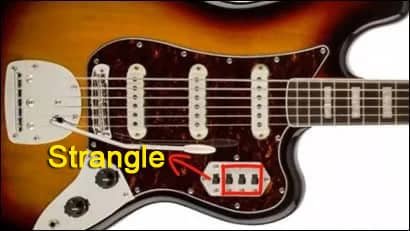
Its price would be between $500. Not a bad price for a guitar with this presence.

The standard strings on the Bass VI range from 24 gauge for the thin string to 84 gauge for the thick string. The sixth string can also be as high as 90 gauge.
Fender Bass VI Baritone Guitar Tuning
The Bass VI tuning is one octave below standard guitar tuning. This is precisely the same standard tuning as a four-string electric bass.
If we put thinner strings on 30″ baritone guitars and raise the tuning relative to the previous tuning, we can achieve a tone closer to that of a guitar than that of a bass, especially on the thicker strings.
Danelectro Baritone
The Danelectro Baritone also has a scale length very close to 30 inches (29.75 inches) and a price of approximately $550.
Because of the longer scale length of a baritone guitar, if we wanted to tune the instrument to a standard guitar pitch, we would have to use extremely thin strings to maintain a certain level of playability. The longer length means that a medium-sized set of strings would be too stiff in standard tuning.
For this reason, the baritone guitar’s design is geared toward very low tunings, relative to standard guitar tuning.
Lowering the tuning would allow us to use thicker strings, and we would obtain the authentic, powerful, and characteristic baritone guitar sound. If we accompany the forcefulness of the baritone guitar sound with a distortion effect, we would obtain a brutal sound, with which we could summon Satan himself.
The baritone guitar would begin to appear in rock and metal music due to its powerful tone. However, today, most baritone guitars have a 27″ scale, three inches shorter than the Danelectro and Fender Bass VI models. These 27″ models are so popular today that we can find guitars with this scale length from most brands.
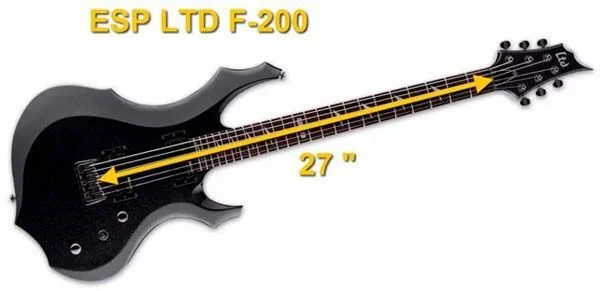
The tunings of 27″ guitars typically fall between A and C. The most commonly used string sets are gauges 13 and 14 for the thin strings, and between 56 and 68 for the thick strings.
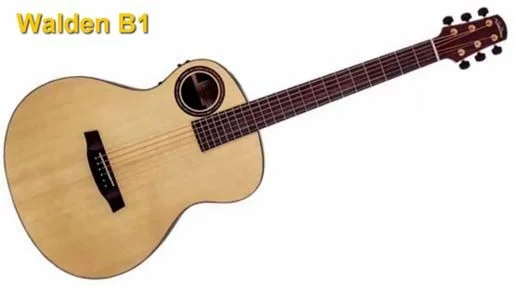
In acoustic guitars we can also find baritone guitars like the Walden B1.
